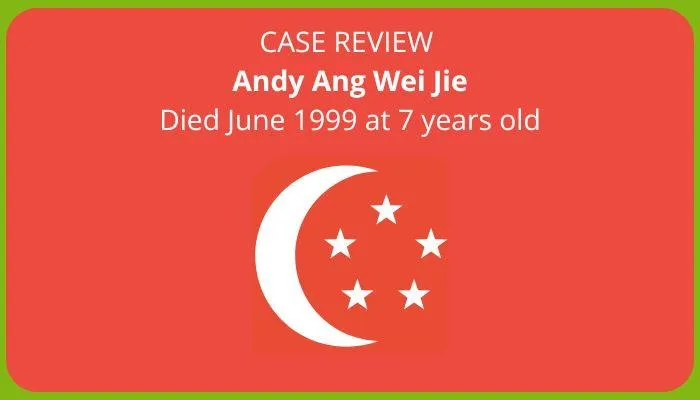Every child's well-being matters.
Best Practice Ideas for Safeguarding Articles
Quick Access

Andy Ang Wei Jie
Summary of the Case
In 1999, a tragic case of child abuse in Ang Mo Kio, Singapore, resulted in the death of a 7-year-old boy. Andy Ang Wei Jie had been systematically abused by her mother’s boyfriend. Investigations revealed that the child suffered severe physical abuse, including repeated beatings and burns. He had 144 injuries at the time of death.
Five years later, Andy’s mother and her boyfriend were both sentenced to prison. The court case underscored the importance of early intervention in suspected child abuse cases and led to strengthened child protection policies in Singapore.
Key Lessons for Early Years Practitioners
You are in the privileged position of being a regular point of contact for every child that comes in through your doors. Your actions could save a life or prevent trauma from deepening.
• Recognising Signs of Abuse
o Look for physical injuries such as bruises, burns, or fractures that lack a reasonable explanation.
o Monitor behavioural changes, including extreme fearfulness, withdrawal, aggression, or reluctance to go home.
o Be aware of neglect indicators, such as poor hygiene, malnutrition, or inadequate clothing.
• Mandatory Reporting and Intervention
o In the UK, safeguarding policies require professionals to report suspected abuse to designated safeguarding leads (DSLs).
o All early years practitioners should be trained to recognise and escalate concerns immediately.
o Familiarise yourself with procedures outlined by local safeguarding children partnerships.
• Building Strong Relationships with Families and Children
o Maintain open communication with families while remaining vigilant for inconsistencies in a child’s well-being.
o Encourage children to express concerns in a safe, supportive environment.
• Multi-Agency Collaboration
o Work closely with social services, healthcare professionals, and law enforcement to ensure a coordinated response to safeguarding concerns.
o Participate in case discussions and contribute observations that may help protect at-risk children.
• Promoting a Culture of Safeguarding
o Regularly update training on child protection and safeguarding regulations.
o Encourage staff to speak up about concerns without fear of repercussions.
o Implement clear policies for reporting and addressing safeguarding issues within the setting.
This case serves as a stark reminder of the importance of vigilance, early intervention, and strong safeguarding measures in protecting vulnerable children. By applying these lessons, early years practitioners in the UK can play a critical role in preventing and addressing child abuse.
AUTHOR:- Iona has nearly 10 years of experience supporting nurseries and childminders in curriculum planning, leadership, and safeguarding. Her writing is informed by public information and sector insight, aiming to provide accessible, practical support for professionals working with children. She is part of the On the Button team, helping deliver Well-being, Safeguarding and Complaint Management Software that empowers practitioners to identify concerns early and act confidently.
On the Button provides innovative software tailored to the needs of the early years sector, with a strong focus on EYFS well-being and early years safeguarding. Our tools help senior practitioners to confidently track concerns, maintain robust records, and respond effectively — all while meeting statutory guidance. From early years complaint management to team-wide safeguarding alerts, our platform puts children's safety and emotional health first.
Quick Access

Andy Ang Wei Jie
Summary of the Case
In 1999, a tragic case of child abuse in Ang Mo Kio, Singapore, resulted in the death of a 7-year-old boy. Andy Ang Wei Jie had been systematically abused by her mother’s boyfriend. Investigations revealed that the child suffered severe physical abuse, including repeated beatings and burns. He had 144 injuries at the time of death.
Five years later, Andy’s mother and her boyfriend were both sentenced to prison. The court case underscored the importance of early intervention in suspected child abuse cases and led to strengthened child protection policies in Singapore.
Key Lessons for Early Years Practitioners
You are in the privileged position of being a regular point of contact for every child that comes in through your doors. Your actions could save a life or prevent trauma from deepening.
• Recognising Signs of Abuse
o Look for physical injuries such as bruises, burns, or fractures that lack a reasonable explanation.
o Monitor behavioural changes, including extreme fearfulness, withdrawal, aggression, or reluctance to go home.
o Be aware of neglect indicators, such as poor hygiene, malnutrition, or inadequate clothing.
• Mandatory Reporting and Intervention
o In the UK, safeguarding policies require professionals to report suspected abuse to designated safeguarding leads (DSLs).
o All early years practitioners should be trained to recognise and escalate concerns immediately.
o Familiarise yourself with procedures outlined by local safeguarding children partnerships.
• Building Strong Relationships with Families and Children
o Maintain open communication with families while remaining vigilant for inconsistencies in a child’s well-being.
o Encourage children to express concerns in a safe, supportive environment.
• Multi-Agency Collaboration
o Work closely with social services, healthcare professionals, and law enforcement to ensure a coordinated response to safeguarding concerns.
o Participate in case discussions and contribute observations that may help protect at-risk children.
• Promoting a Culture of Safeguarding
o Regularly update training on child protection and safeguarding regulations.
o Encourage staff to speak up about concerns without fear of repercussions.
o Implement clear policies for reporting and addressing safeguarding issues within the setting.
This case serves as a stark reminder of the importance of vigilance, early intervention, and strong safeguarding measures in protecting vulnerable children. By applying these lessons, early years practitioners in the UK can play a critical role in preventing and addressing child abuse.
AUTHOR:- Iona has nearly 10 years of experience supporting nurseries and childminders in curriculum planning, leadership, and safeguarding. Her writing is informed by public information and sector insight, aiming to provide accessible, practical support for professionals working with children. She is part of the On the Button team, helping deliver Well-being, Safeguarding and Complaint Management Software that empowers practitioners to identify concerns early and act confidently.
On the Button provides innovative software tailored to the needs of the early years sector, with a strong focus on EYFS well-being and early years safeguarding. Our tools help senior practitioners to confidently track concerns, maintain robust records, and respond effectively — all while meeting statutory guidance. From early years complaint management to team-wide safeguarding alerts, our platform puts children's safety and emotional health first.

Andy Ang Wei Jie
Summary of the Case
In 1999, a tragic case of child abuse in Ang Mo Kio, Singapore, resulted in the death of a 7-year-old boy. Andy Ang Wei Jie had been systematically abused by her mother’s boyfriend. Investigations revealed that the child suffered severe physical abuse, including repeated beatings and burns. He had 144 injuries at the time of death.
Five years later, Andy’s mother and her boyfriend were both sentenced to prison. The court case underscored the importance of early intervention in suspected child abuse cases and led to strengthened child protection policies in Singapore.
Key Lessons for Early Years Practitioners
You are in the privileged position of being a regular point of contact for every child that comes in through your doors. Your actions could save a life or prevent trauma from deepening.
• Recognising Signs of Abuse
o Look for physical injuries such as bruises, burns, or fractures that lack a reasonable explanation.
o Monitor behavioural changes, including extreme fearfulness, withdrawal, aggression, or reluctance to go home.
o Be aware of neglect indicators, such as poor hygiene, malnutrition, or inadequate clothing.
• Mandatory Reporting and Intervention
o In the UK, safeguarding policies require professionals to report suspected abuse to designated safeguarding leads (DSLs).
o All early years practitioners should be trained to recognise and escalate concerns immediately.
o Familiarise yourself with procedures outlined by local safeguarding children partnerships.
• Building Strong Relationships with Families and Children
o Maintain open communication with families while remaining vigilant for inconsistencies in a child’s well-being.
o Encourage children to express concerns in a safe, supportive environment.
• Multi-Agency Collaboration
o Work closely with social services, healthcare professionals, and law enforcement to ensure a coordinated response to safeguarding concerns.
o Participate in case discussions and contribute observations that may help protect at-risk children.
• Promoting a Culture of Safeguarding
o Regularly update training on child protection and safeguarding regulations.
o Encourage staff to speak up about concerns without fear of repercussions.
o Implement clear policies for reporting and addressing safeguarding issues within the setting.
This case serves as a stark reminder of the importance of vigilance, early intervention, and strong safeguarding measures in protecting vulnerable children. By applying these lessons, early years practitioners in the UK can play a critical role in preventing and addressing child abuse.
AUTHOR:- Iona has nearly 10 years of experience supporting nurseries and childminders in curriculum planning, leadership, and safeguarding. Her writing is informed by public information and sector insight, aiming to provide accessible, practical support for professionals working with children. She is part of the On the Button team, helping deliver Well-being, Safeguarding and Complaint Management Software that empowers practitioners to identify concerns early and act confidently.
On the Button provides innovative software tailored to the needs of the early years sector, with a strong focus on EYFS well-being and early years safeguarding. Our tools help senior practitioners to confidently track concerns, maintain robust records, and respond effectively — all while meeting statutory guidance. From early years complaint management to team-wide safeguarding alerts, our platform puts children's safety and emotional health first.
Quality Early Years Ltd.,
Dickens House,
Guithavon Street,
Witham, Essex,
England, CM8 1BJ
© Quality Early Years Ltd 2025
On the Button are Finalists for 3/3 Early Years Awards!
Find On the Button
on Social Media

